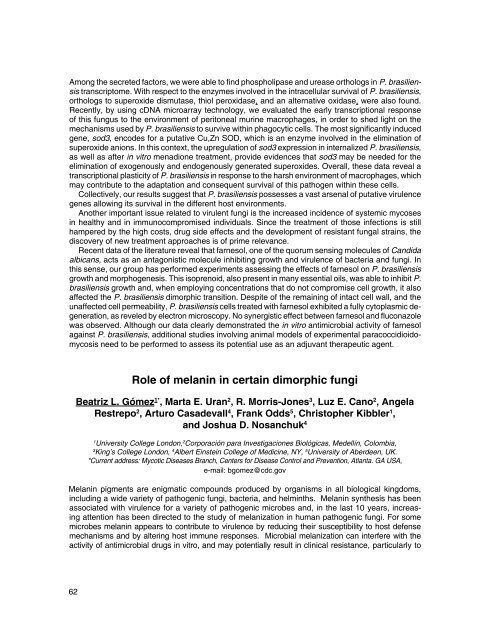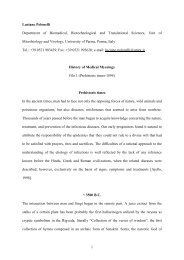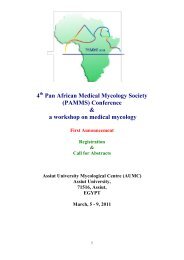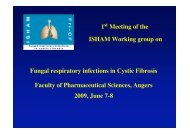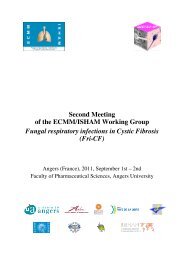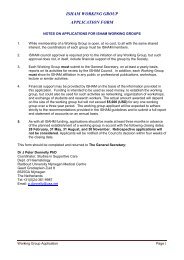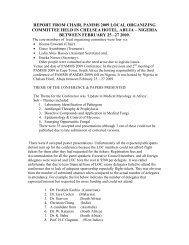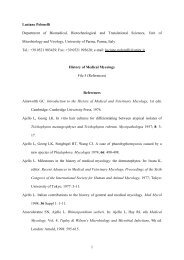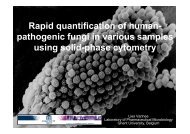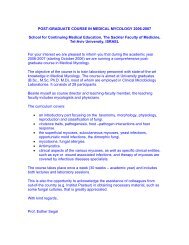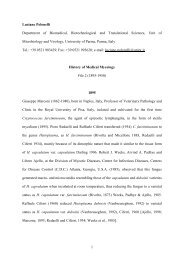Memoria CD.indd - ISHAM
Memoria CD.indd - ISHAM
Memoria CD.indd - ISHAM
You also want an ePaper? Increase the reach of your titles
YUMPU automatically turns print PDFs into web optimized ePapers that Google loves.
Among the secreted factors, we were able to find phospholipase and urease orthologs in P. brasiliensistranscriptome. With respect to the enzymes involved in the intracellular survival of P. brasiliensis,orthologs to superoxide dismutase, thiol peroxidase, and an alternative oxidase, were also found.Recently, by using cDNA microarray technology, we evaluated the early transcriptional responseof this fungus to the environment of peritoneal murine macrophages, in order to shed light on themechanisms used by P. brasiliensis to survive within phagocytic cells. The most significantly inducedgene, sod3, encodes for a putative Cu,Zn SOD, which is an enzyme involved in the elimination ofsuperoxide anions. In this context, the upregulation of sod3 expression in internalized P. brasiliensis,as well as after in vitro menadione treatment, provide evidences that sod3 may be needed for theelimination of exogenously and endogenously generated superoxides. Overall, these data reveal atranscriptional plasticity of P. brasiliensis in response to the harsh environment of macrophages, whichmay contribute to the adaptation and consequent survival of this pathogen within these cells.Collectively, our results suggest that P. brasiliensis possesses a vast arsenal of putative virulencegenes allowing its survival in the different host environments.Another important issue related to virulent fungi is the increased incidence of systemic mycosesin healthy and in immunocompromised individuals. Since the treatment of those infections is stillhampered by the high costs, drug side effects and the development of resistant fungal strains, thediscovery of new treatment approaches is of prime relevance.Recent data of the literature reveal that farnesol, one of the quorum sensing molecules of Candidaalbicans, acts as an antagonistic molecule inhibiting growth and virulence of bacteria and fungi. Inthis sense, our group has performed experiments assessing the effects of farnesol on P. brasiliensisgrowth and morphogenesis. This isoprenoid, also present in many essential oils, was able to inhibit P.brasiliensis growth and, when employing concentrations that do not compromise cell growth, it alsoaffected the P. brasiliensis dimorphic transition. Despite of the remaining of intact cell wall, and theunaffected cell permeability, P. brasiliensis cells treated with farnesol exhibited a fully cytoplasmic degeneration,as reveled by electron microscopy. No synergistic effect between farnesol and fluconazolewas observed. Although our data clearly demonstrated the in vitro antimicrobial activity of farnesolagainst P. brasiliensis, additional studies involving animal models of experimental paracoccidioidomycosisneed to be performed to assess its potential use as an adjuvant therapeutic agent.Role of melanin in certain dimorphic fungiBeatriz L. Gómez 1* , Marta E. Uran 2 , R. Morris-Jones 3 , Luz E. Cano 2 , AngelaRestrepo 2 , Arturo Casadevall 4 , Frank Odds 5 , Christopher Kibbler 1 ,and Joshua D. Nosanchuk 41University College London, 2 Corporación para Investigaciones Biológicas, Medellín, Colombia,3King’s College London, 4 Albert Einstein College of Medicine, NY, 5 University of Aberdeen, UK.*Current address: Mycotic Diseases Branch, Centers for Disease Control and Prevention, Atlanta. GA USA,e-mail: bgomez@cdc.govMelanin pigments are enigmatic compounds produced by organisms in all biological kingdoms,including a wide variety of pathogenic fungi, bacteria, and helminths. Melanin synthesis has beenassociated with virulence for a variety of pathogenic microbes and, in the last 10 years, increasingattention has been directed to the study of melanization in human pathogenic fungi. For somemicrobes melanin appears to contribute to virulence by reducing their susceptibility to host defensemechanisms and by altering host immune responses. Microbial melanization can interfere with theactivity of antimicrobial drugs in vitro, and may potentially result in clinical resistance, particularly to62


